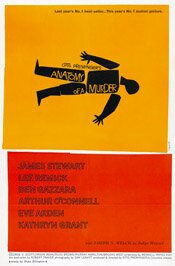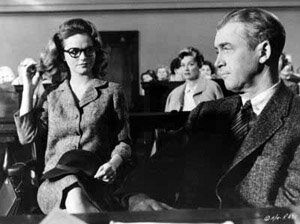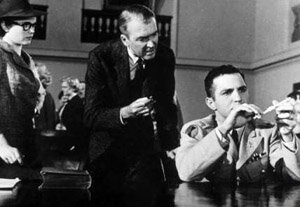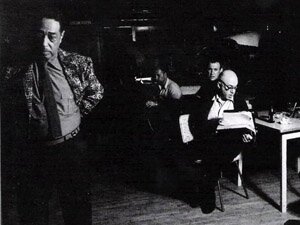It’s Day 4 of For the Love of Film (Noir) — don’t forget to or use the button on the right. And if you are interested in boatloads of great links to musings on film noir and its films, scroll down this page at Self-Styled Siren or over at Ferdy on Films. This is wonderful material!
 What I like about Anatomy of a Murder is that every so often a friend will say something like, “… This movie I saw on TV was so good …” As they describe it I realize what movie they mean and remark, “That’s Anatomy of a Murder.”
What I like about Anatomy of a Murder is that every so often a friend will say something like, “… This movie I saw on TV was so good …” As they describe it I realize what movie they mean and remark, “That’s Anatomy of a Murder.”
“Yeah! That’s what it was called!”
I mention this because many of these people usually have to make what I called cognitive adjustments in a post not long ago. They don’t like “old movies.” Black and white, pacing, sensibility … all kinds of things can impede us from entering a movie because we are used to one kind of film (contemporary) and something old, foreign or both requires some readjustment.
Some require less adjusting than others, however. Anatomy of a Murder is one of them. Despite being a movie from 1959, it feels very modern. Part of it is in the subject matter; part of it is in the way it handles and views that subject matter; it’s partly Duke Ellington’s music for the soundtrack.
Whenever I watch this movie I find myself wondering what is going on behind the eyes of the main characters. I never figure it out. Everyone is so cagey and ambivalent. It’s as if none of them have a moral compass. They exist in a world where that is just excess baggage and only gets in the way.
What follows are the ramblings I made about the movie about ten years ago as I tried get my take on …
 Anatomy of a Murder (1959)
Anatomy of a Murder (1959)
Directed by Otto Preminger
Although I was confused about where exactly Anatomy of a Murder was taking place (Michigan, it seems), it’s a great, enthralling courtroom drama of the noir variety.
It has a great late 50’s black and white look, somewhat similar to Kiss Me Deadly, though this is a far better film. (I wouldn’t take the similarity very far either. It’s just something in the period look they have in common.)
Jimmy Stewart is great in this movie. Some argue it’s his best performance, and there’s something to be said for that.
He has the laconic air and halting speech he’s famous for and it works well here as a kind of strategic approach to getting at the truth of things. It catches others off guard.
He’s a small town lawyer, formerly chief prosecutor (holding the post for ten years). Why he’s no longer in the position isn’t really explained but you get hints his leaving was under a shadow, or at least troubled somehow.

Lee Remick and Jimmy Stewart in Anatomy of a Murder (1959).
It seems all his character does now is fish, drink and take small, penny-ante cases to pay his bills (which he does badly). Then a big case falls in his lap.
After taking a long time asking questions, mulling things over, and in no apparent hurry to get involved, he finally takes the case and the film really gets underway. (In fact the first portion of the film is a bit slow.)
The case he has is this: a woman (Lee Remick) has been raped. Her soldier husband (Ben Gazzara) has gone out and shot the alleged rapist dead. The soldier is now on trial for murder. Stewart’s job is to defend the soldier. But as he points out to his client, there is really no defense for him … except, possibly, one. The murder being deliberate (an hour after hearing from his wife about the rape), he can’t argue passion. The time element makes it pre-meditated. Gazzara’s only hope is to argue for insanity – an “irrepressible urge.”
There are various complications along the way, including help for the prosecution via the Attorney General’s office in the person of George C. Scott who plays his role with relish, informing it with a kind of conniving smugness.

Lee Remick, Jimmy Stewart and Ben Gazzara in Anatomy of a Murder (1959).
What really sets Anatomy of a Murder in the noir category is its overarching moral ambivalence. If you pay attention as you watch, you realize that there really are no “good guys” here – not even Stewart, though his performance and the direction align the audience’s sympathies with him.
But he’s defending a man who has committed murder. He is trying to get him off scott free.
You know by what Gazzara says and doesn’t say, and by his performance, that he is guilty. And you know Stewart knows this when he takes the case. The trial is really about playing fast and loose with the law. And both sides in the case do this.
In the case of the woman who was raped, the incident seems to have meant little more to her than stubbing a toe. It’s as if somewhat had given her a quick kiss, not violently raped her.
Of course, her character is a victim in other ways. She’s slatternly and flirtatious and you know from certain scenes, and by the way Remick plays her, she is a woman trapped by abusive men. She’s lonely and seems to gravitate toward men who treat her badly. Her relationship with her husband, Gazzara, suggests domestic violence, though it’s implied and not overtly stated.

Duke Ellington and Otto Preminger on the set of Anatomy of a Murder (1959).
At the end of the movie, while there is a resolution (the trial ends) there is no moral resolution. Nothing has changed. Justice has been thrown out the window. The victim will continue to be victimized. While the man who raped her may be dead, she continues on with the one who abuses her.
(It’s interesting to see how her character changes in the film, allows us to see more of who she is, such as her lonliness, then at the film’s end, as she meets Stewart’s character going up the stairs to hear the verdict, she’s back to her previous clothing and flirtatious manner. Again, nothing has changed.)
Despite a few Hollywood elements to lighten the tone at the end, this is a dark film. The hero, Stewart, at the end is little better than those he has been up against.
The movie concludes with a wry look from Jimmy Stewart and a tone of bemused hopelessness as if the director, Otto Preminger, is saying, “That’s people for you. What can you do?”
One last note … The movie’s music was composed by Duke Ellington and it really gives it a unique quality, particularly for the period it was made, and adds to the movie’s overall atmosphere. Ellington also has an uncredited appearance in the movie as Pie Eye, owner of a roadhouse where Jimmy Stewart’s character sometimes goes to play piano.



Pingback: Ferdy on Films
Great writeup of a great film. I especially love the dialogue in this – it sparks and crackles, and Stewart’s performance is remarkable, bringing so much of that characteristic Stewart charm to a character who’s in many ways quite unlikeable, a washed-up loser who wants his big break so badly that he’ll bend and twist and mock the judicial system to get it. The film made a sensation at the time, believe it or not, for being the first film in which the word “panties” appeared, and Preminger loved those kinds of provocations, those little tweaks at the dying Hays Code. But the film’s endurance belies the oft-repeated idea that Preminger was little more than a provocateur. The film’s verbal and visual delights – all those sweeping shots that jazz up the staid courtroom setting – and its thematic implications make this a truly great film. It’s up there with BONJOUR TRISTESSE as one of Preminger’s very best.
Thanks for the comment. Yes, I’ve always liked this movie. And I remember Preminger years ago on things like the Tonight Show and how there was always something a little mischievous in his eyes. I can understand how he would love a dust up over a word like panties.
Bill, I really enjoyed your comments on one of my favorite films. As many times as I’ve watched this film it always appears fresh to me.
It does look very modern and well shot in black and white too. The thing that really sets it apart from other courtroom dramas though, is it’s adult frankness with the dialogue and overall style, especially with the court room scenes.
George C. Scott brings his characteristic dynamic persona to his role of the prosecutor brought in from the outside to assist in the trial. It’s an absolute joy to watch his scenes because you realize you’re watching a great actor truly enjoying his work in every scene he is in. The odd choice of casting real-life judge Joseph Welch was also a stroke of genius as his matter-of-factness just adds to the realism of the courtroom scenes.
All of the actors seem well cast, even down to the also-odd casting of Orson Bean as a young psychiatrist. Bean was mostly a game show guest and comedian but he adds a very nice naturalness to his acting, as does Howard McNear (Floyd the barber in Andy Griffith) in his courtroom scenes.
As you mentioned, Ellington composed the score, which really gave the movie a kind of jazzy, gritty feel to it. The ambiguous ending was also a great touch, finishing off that rare thing– an intelligent drama truly made for adults.
Pingback: Tweets that mention Who dunnit? What did they do? Who cares? – Anatomy of a Murder -- Topsy.com
Lee Remick is one of my favorite new finds from last year. I’m so glad TCM featured her during their Summer Under the Stars month of August. She is such a fantastic actress and her performance in Anatomy of a Murder has got to be one of the most sexy roles ever.
Barney … I agree 100%. I love Scott in this movie. I also think this is one of the best courtroom dramas. I love the fact that so much of what makes the movie dramatically compelling takes place in one room, all in the script, dialogue and acting. (Oh yes, directing and editing too.)
But I didn’t need the Orson Bean reminder. I had forgotten about him. Now I have to watch the movie again.
(A billion years ago I use to see him in on those game shows and the Tonight Show. I always liked him.)
Marya … I remember interviews and TV appearances of Lee Remick when I was young and could never figure out why. Who was she? Then I started really watching movies and seeing her, especially in Anatomy of a Murder. Then I knew why. Before seeing this movie, I had no idea she could be so sexy!
Wonderful essay. I love Duke Ellington and this movie gives a nice dose. It’s a shame he didn’t do more film scores. Lee Remick’s character seems more real than female characters in other movies from the same period. Joe Welch is immortal for telling off Senator McCarthy (Have you no sense of decency, sir? At long last, have you left no sense of decency?), so he brings a nice subtext to his performance as the judge.
Joe, I agree with all your comments. I have an Ellington disc (“Blues in Orbit”) with Pie Eye’s Blues, another take on the theme and it’s one of my favourite Ellington pieces.
Bill, I apologize for the inclusion of Orson Bean in my comments but I just couldn’t resist.
Pingback: A good time had by all
The dvd I watched stopped working at the end..how does this movie end?
He is found not guilty by reason of insanity
Always loved the movie but hate the ending. Totally illogical that Stewart and O’Connell merely laugh at themselves for being duped. An airhead wife continues to live with her abuser, some poor slob lies in the grave unavenged, and these two lawyers just freed the abuser/murderer! Ha-ha-ha! I’d like to smash their grinning mugs! There now, I feel much better.
Jay, I found all of those things to be so very true to life. People get away with bad things. Abusive people keep on being abusive. You get gypped out of $3,000. Oh well, that’s life! What can you do about it?
Jay, thank you for your comments on this great film. Yes, I totally agree that Scott was wonderful in the role of the prosecuting attorney. He was also splendid a few years later
opposite Paul Newman in Robert Rossen’s The Hustler. It is interesting that Stewart and
Preminger would not work again, but without a doubt this is one of the actors most
compelling performances. Preminger, unlike many of his contemporaries, was willing to
challenge the viewer to consider our own moral choices against the views of his films’
protagonists. Again, thanks for your insights. William McDonald
Pingback: Flicks Friday: Attitude Towards Rape in 1950s America, Part 1: Anatomy Of A Murder (1959) |
I grew up in Waterville, Maine and I thought the mirinesies of Richard Russo’s “Empire Falls” really “got” that town. I lived for some time in San Diego and the new series “Terriers” is a spot-on portrait of that city.I love the portrait of LA in Steve Martin’s “LA Story.” But there are so many LA films, it would be hard to choose one: Chinatown, LA Confidential, Mulholland Drive, etc.But I don’t know if any film has got the essence of the part of coastal CA where I live now. Maybe I’ll have to write it…
I have always wondered about the “poetic justice” comment at the end of the film. Does it mean Biegler plans on suing Lt. Manion for killing Mary Pilant’s father and the financial as well as emotional losses she has had to endure? That would make it more of a poetic justice, than just handling Barney’s estate. The ending just didn’t seem real clear on what was the poetic justice. Anyone wish to wise me up on this point. Other than that it is just a terrific movie. Maybe the lawyers have problems with it, but for average joe’s, it rings true.
I have to admit that I don’t like the ending entirely, but my read on poetic justice is that there will be no true justice and that the only found justice is that it means their administration of the estate is an ironic twist in which virtue is ultimately rewarded. The plot is fairly tight but I have to admit that by the end of it, I question whether rape in fact happened. If Barney Quill had really done it and was worried about Manion coming to the bar to attack him (Paquette posted as guard at the bar), why would he have taken the panties and casually put them down the laundry chute? Couldn’t Quill or wife Laura have planted this. Great movie, but it does seem like the two dysfunctional “victims” (Barney and Laura) both outsmarted the savvy attorneys. Maybe that’s the real poetic justice.